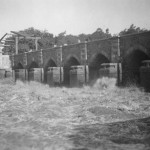Ailsa has been in some pretty rainy places recently and had no trouble finding reflective puddles of liquid: http://wheresmybackpack.com/2012/11/23/travel-theme-liquid/
But since my source of photos is from Egypt, an ancient country where rain falls little and seldom, I thought of the two photos here below that show ingenious methods of sustaining life in a dry land. During the Hellenistic era (333 – 30 BC) two technological devices were invented to transfer water to farmlands from the Nile or from underground wells fed by the Nile. The first photo is of a saqiya or Persian water-wheel, a machine which freed up human labour for tasks other than manually carrying buckets of water from the Nile to the crops, or lifting buckets of water from the river and pouring it into a channel. The saqiya uses animal power: bullocks, buffalo, donkeys, camels or cows, which tread circles around the horizontal wheel, turning the vertical wheel connected to the clay-pot laden wheel. The pots are positioned on a set of ropes so they tilt forward when they rise out of the well and empty into a trough before descending into the well to fill again.
Thousands of saqiyas are still in use today in Egypt.

In the second photo, a device called a tambour, or Archimedes Screw, consists of a large tube inside which a spiral chamber turns and scoops up water when rotated by a handle. The water travels up the length of the screw chamber and is poured out the top of the tube into irrigation channels. Its inventor, Archimedes, is said to have been the first to use the water screw, in 230 BC. This technology is now rare in Egypt but is still used for irrigation in other parts of the world.





Fascinating!
Oh, thanks!